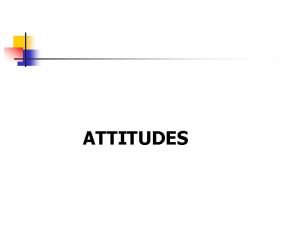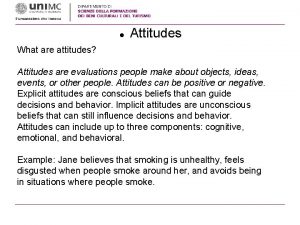Survey of Attitudes Toward Statistics American vs Chinese












- Slides: 12

Survey of Attitudes Toward Statistics American vs. Chinese Business Students Ping Wang wangpx at jmu. edu Computer Information Systems/Business Analytics College of Business, James Madison University, Harrisonburg, VA SEDSI, February 22 – 24, Charleston, SC

Drivers for Learning Business Statistics • Interest • Career

Characteristics of Students • Google generation • Low attention span

Motivating Students to Learn Business Stats • Keep students interested, engaged • Affect • Value • Interest • Learning to teach problem solving • • Cognitive competence Difficulty Effort Pedagogical issues

Survey of Attitudes Toward Statistics (SATS) by Schau et al. , 1995 1. Statistics anxiety relates to: negative experience, less appreciative of values and usefulness, less of confidence or competent, with negative feeling 2. Unfavorable attitudes often relate to poor achievements 3. Attitudes Components: a) Affect: (6 items): positive and negative feelings about statistics. Such as, I enjoy taking statistics courses. b) Cognitive Competence (6 items): intellectual knowledge and skills applied to statistics. Such as I understand statistics equations. c) Value (9 items): usefulness, relevance, and worth of statistics in personal and professional life. Such as Statistics is irrelevant to my life. d) Difficulty (7 items): perception of difficulty of statistics as a subject. Such as, Statistics is a complicated subject. e) Interest (4 items): individual level of interest. Such as, I am interested in using statistics. f) Effort (4 items): amount of work to learn statistics. Such as, I plan to work hard in my statistics course. Atkinson 1957, Eccles and Wigfield 1995, Weiner 1979, Bandura 1977, Maehr 1984, Kamirez et al. 2012

Attitude toward Business Statistics --- USA vs. China 41. Your sex: USA China Male 1 129 Female 2 99 Total 228 56 125 181 185 224 409

American vs. Chinese Students Group Comparison • Chinese students rated much higher on Affect, Cognitive Competence, and Value components • American students rated higher on Difficulty, Interest, and Effort components • Affect: American students rated just slightly over neutral while Chinese students rated moderately positive • Cognitive Competence & Interest: Both groups rated moderately positive • Value: Both groups rated very positive at around 5. 5 to 6 out of 7 • Difficulty: Both groups rated moderately negative • Effort: Both groups rated extremely positive Remarks: 1) 2) Group means are statistically significantly different at p – value of *** 0. 01, ** 0. 05, and * 0. 10 levels The number after * refers to the group difference, i. e. , 0. 64 of the 1 (strongly disagree) to 4 (neutral) to 7 (strongly agree) of Likert scale

American vs. Chinese Male Business Students Group Comparison • Chinese male students rated much higher on Affect, Cognitive Competence, and Value components • American male students rated higher on Effort component • Both groups male students rated same levels on Difficulty and Effort components • Affect: Both groups male students rated moderately positive • Cognitive Competence & Interest: Both groups male students rated moderately positive • Value: American male students rated moderately positive while Chinese male students rated very positive • Difficulty: Both groups rated moderately negative • Effort: Both groups rated extremely positive Remarks: 1) 2) Group means are statistically significantly different at p – value of *** 0. 01, ** 0. 05, and * 0. 10 levels The number after * refers to the group difference, i. e. , 0. 64 of the 1 (strongly disagree) to 4 (neutral) to 7 (strongly agree) of Likert scale

American vs. Chinese Female Business Students Group Comparison • Chinese female students rated much higher on Affect, Cognitive Competence, & Value components • American female students rated higher on Interest & Effort component • Both groups male students rated same level on Difficulty component • Affect: American female students rated neutral while Chinese female students rated moderately positive • Cognitive Competence & Interest: Both groups male students rated moderately positive • Value: Both groups female students rated very positive • Difficulty: Both groups rated moderately negative • Effort: Both groups rated extremely positive Remarks: 1) 2) Group means are statistically significantly different at p – value of *** 0. 01, ** 0. 05, and * 0. 10 levels The number after * refers to the group difference, i. e. , 0. 64 of the 1 (strongly disagree) to 4 (neutral) to 7 (strongly agree) of Likert scale

American Business Students by Gender Group Comparison • American male students rated much higher on Affect, Cognitive Competence, & Difficulty components • Both male and female groups rated same levels on Value, Interest, and Effort components • Affect: American male students rated moderately positive while American female students rated neutral • Cognitive Competence & Interest: Both groups rated moderately positive • Value: Both groups rated moderately to very positive • Difficulty: Both groups rated moderately negative • Effort: Both groups rated extremely positive Remarks: 1) 2) Group means are statistically significantly different at p – value of *** 0. 01, ** 0. 05, and * 0. 10 levels The number after * refers to the group difference, i. e. , 0. 64 of the 1 (strongly disagree) to 4 (neutral) to 7 (strongly agree) of Likert scale

Chinese Business Students by Gender Group Comparison • Chinese male students rated much higher on Interest component while female students rated much higher on Effort component • Both male and female groups rated same levels on Affect, Cognitive Competence, Value, and Difficulty components • Affect, Cognitive Competence & Interest: Both male and female students rated moderately positive • Value: Both groups rated very positive • Difficulty: Both groups rated moderately negative • Effort: Chinese male students rated moderately positive while female students rated extremely positive Remarks: 1) 2) Group means are statistically significantly different at p – value of *** 0. 01, ** 0. 05, and * 0. 10 levels The number after * refers to the group difference, i. e. , 0. 64 of the 1 (strongly disagree) to 4 (neutral) to 7 (strongly agree) of Likert scale

 Who was babur
Who was babur British social attitudes survey
British social attitudes survey Anglo chinese school primary
Anglo chinese school primary Acls secondary survey
Acls secondary survey American born chinese anticipation guide
American born chinese anticipation guide American born chinese analysis
American born chinese analysis Amy tan the american-born daughter of chinese immigrants
Amy tan the american-born daughter of chinese immigrants Sancar flats
Sancar flats Introduction to statistics what is statistics
Introduction to statistics what is statistics American statistical association salary survey
American statistical association salary survey Module 74: attribution, attitudes, and actions
Module 74: attribution, attitudes, and actions Tripartite model of attitudes
Tripartite model of attitudes New zealand attitudes and values study
New zealand attitudes and values study























